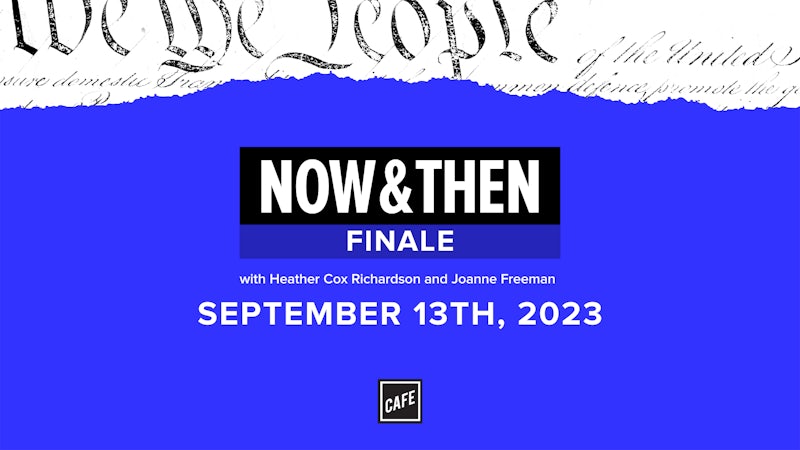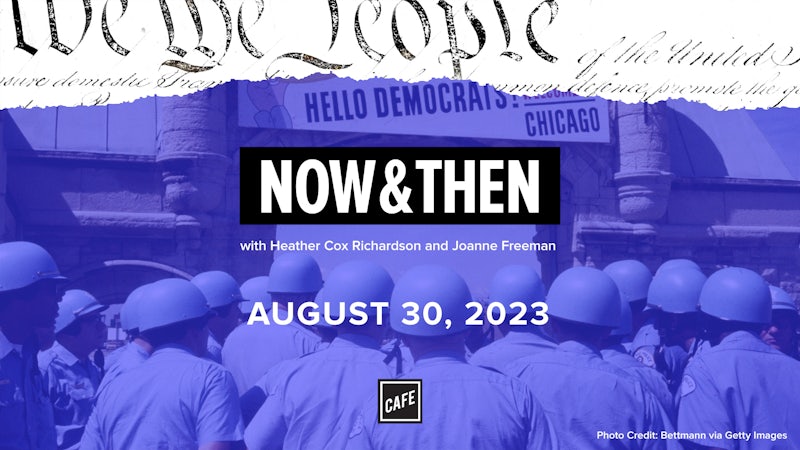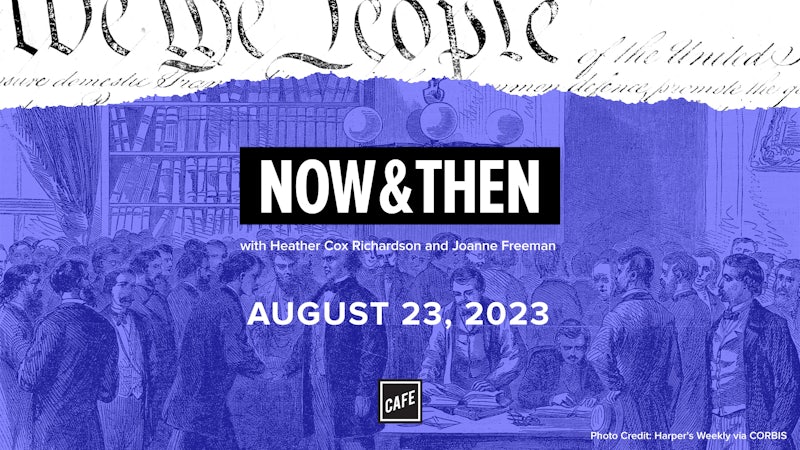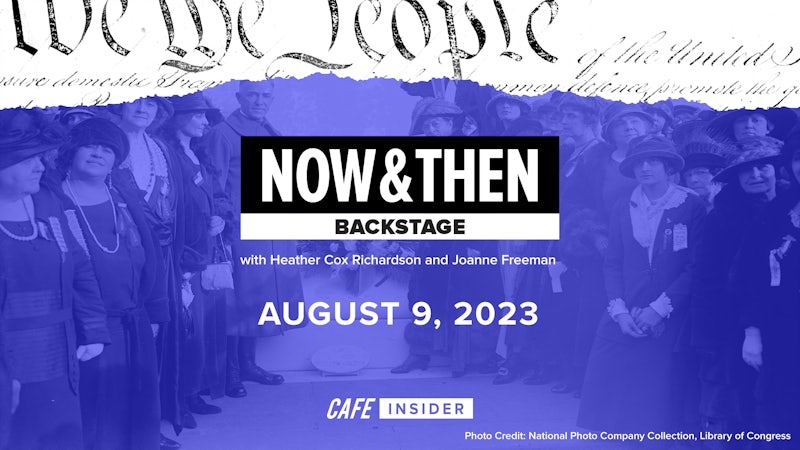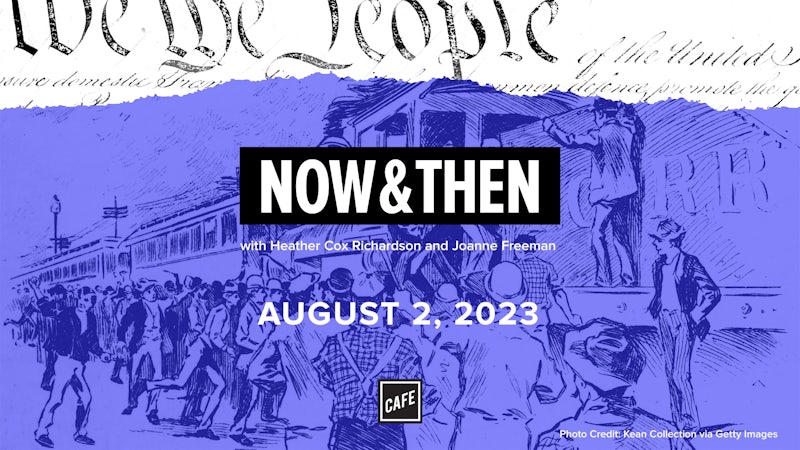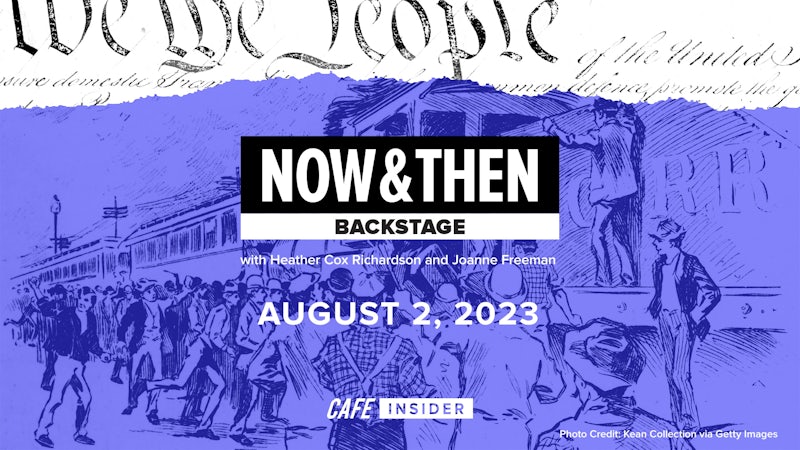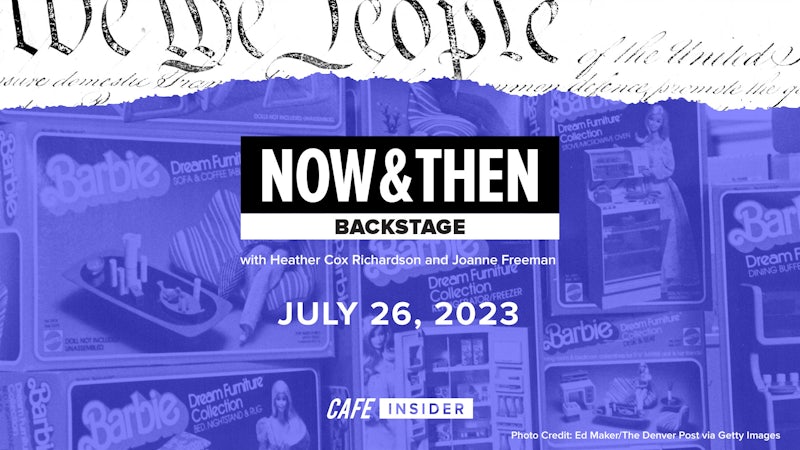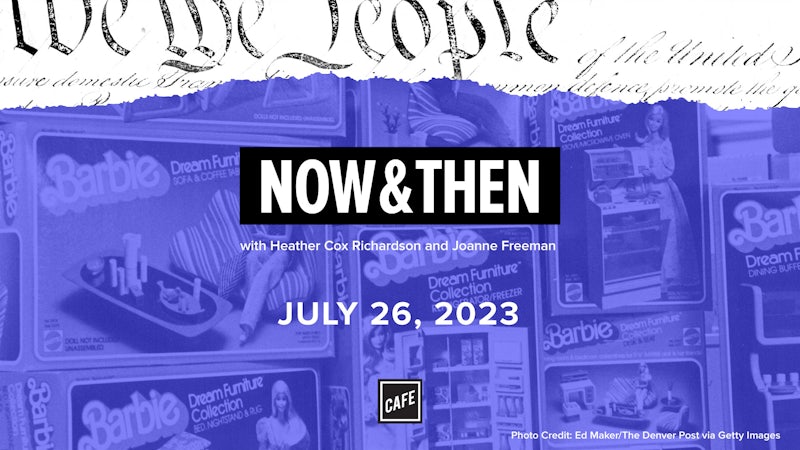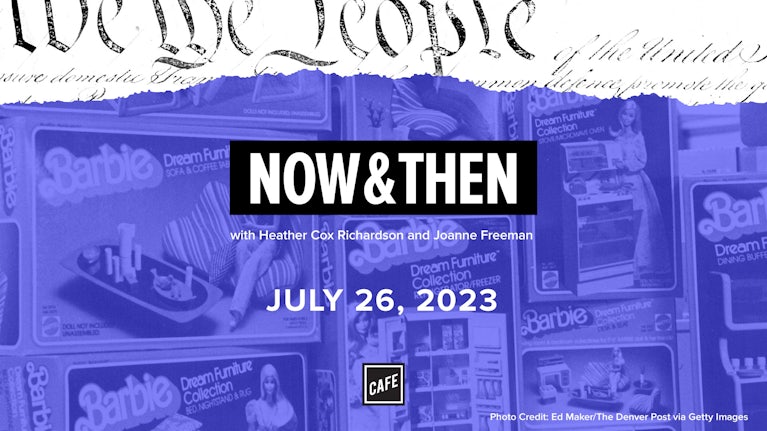Heather Cox Richardson:
From Cafe and the Box Media Podcast Network, this is Now and Then. I’m Heather Cox Richardson.
Joanne Freeman:
And I’m Joanne Freeman. Here we are, we’ve gotten ourselves to August and we are at the time of year when people are taking vacations. Even our producer, David, is taking time off and going on vacation. I salute him for taking a vacation. But for this reason, we thought that today would be an excellent time for us to talk about how Americans take and have taken vacations in the past. And maybe bigger than that, how the idea of traveling for leisure or fun or however else people have justified vacation time, how that’s evolved over time.
Now, it’s worth noting, and this is interesting given vacationing during a pandemic is an interesting topic all by itself, that a survey conducted in April suggested that nearly 3/4s of American adults had summer vacation plans, which is a pretty big jump from last year when only about 53% had plans. And people this summer are planning to spend a lot more money on those vacations as well, partly because of inflation, but also partly because the travel industry is rebounding. I have heard, certainly, lots of stories about swamped airports and not enough pilots and all kinds of things that are happening because people are now coming back into traveling and actually taking vacations.
But the one thing that might be different this year for some people is that vacations, not just beginning this year, but particularly if people are swarming back into vacation land, one thing that might be different is not just email, but zooming and work platforms like Slack. There might be all these ways in which people on vacation may or may not totally stay on vacation. And I don’t know what I would do given a similar situation, so it’ll be interesting to see even now how the idea of a vacation is evolving.
Heather Cox Richardson:
Well, it is interesting that the United States is the only advanced economy that doesn’t guarantee paid vacation and holidays. And that changes, of course, the way we think about vacations and the way we think about working on vacations, because you’re absolutely right, the idea of really taking time off is foreign now, I think, to a lot of people.
But it does raise the question of what a vacation is for. I can think of a number of reasons that one would go on vacation. One is simply to give your brain and your body rest from your usual routine, another is to see the world and to make connections across different cultures, and a third is to learn new things. And those three things are not always compatible. And it does raise the question of why somebody would decide to make a break in their usual routine.
Joanne Freeman:
Totally true. And I’d say even there’s a fourth reason that a lot of people used in early America, certainly in the late 18th and early 19th century to justify vacation taking. And in a sense, the fourth reason really pretty much makes it not a vacation. People would say it was for their health, not just to rest their brain or rest their bodies, but really going to hot springs or warm springs and taking the waters, as it might have been called, to improve their health. And this was a very fashionable thing to do, particularly in the south.
But if you think about what that meant at the time, going to take the waters at thermal springs or mineral springs, and places like Virginia actually was very popular place to go, typically people who did that went away for weeks at a time. And it was really costly to do that. When you’re talking about that as a vacation… And again, people at the time would say, “For my health, I must go to the warm springs in Virginia.” Even so, they were spending weeks away from wherever they were from. Clearly, they were not people that had a typical job. They were probably landholders in the south. They would’ve been plantation owners. And they paid a lot of money for those several-week visits. We’re not talking about the idea of vacation taking for the average American at that point. It very much is almost a seemingly aristocratic thing justified for a reason, not just taken as a way to have fun.
Heather Cox Richardson:
Well, when I think about early America, I always think about women who complain bitterly about the fact that a man, he works from sun to sun, but a woman’s work is never done. And it wasn’t like you could go off and leave the cows if you were lucky enough to have cows, because they have to be milked on a schedule. The idea of having a break in your routine really did mean that you had money. But I have a question for you about taking the waters that I’ve always wondered about. And this may be really stupid, but does that mean you sit in them or drink them or both?
Joanne Freeman:
Both. I’ve actually done that once.
Heather Cox Richardson:
Really?
Joanne Freeman:
Yes.
Heather Cox Richardson:
Not at the same time.
Joanne Freeman:
Well, you’re not drinking what you’re sitting in at that moment. I have actually once gone to a spa. And I will acknowledge that I had a spa phase in my life. Once a year, I’d take a vacation and I would go to some spa. And like not a super fancy one, but in one case it was in Florida and it was centered around its thermal mineral waters. And so you would sit in the waters, but then there was also containers full of the waters, which were supposed to be extra bonus healthy for you and that you were supposed to drink as well. This was many moons ago. I have no idea. I bet I didn’t do any research of any kind to have any idea whether any of this had any basis in reality. But the idea of it, of luxuriating in this nice place where I didn’t have to do anything and I was just basically sitting in a jacuzzi and drinking water, that was okay. I was okay with that. And if it helped my health, wonderful. But it was a combination.
Heather Cox Richardson:
We’ve already put the guardrails around it that these are going to be people of wealth. What I think about are people, sometimes families going to Europe. And I don’t know, what does that even look like?
Joanne Freeman:
There were different ways and reasons to go to Europe. And it’s worth remembering that if we’re talking about the late 18th and early 19th centuries, the grand capitals of Europe, London and Paris, were seen as the world centers of civilization, and the United States, even to Americans was seen as this backwater. When Americans went to Europe, they weren’t just, “Ah, let’s go see the sites,” it was let us go to the land of culture, the land of history. It was a cultural center of one kind or another.
And people went there for different reasons. American painters tended to go there not so much for vacation, but to get classical training and painting. And young men in particular, not necessarily families, but young men sometimes would be sent abroad to learn and to see the world and get a larger sense of the world, maybe learn languages, gain some independence. And they would go from country to country looking at the sites and mingling with other aristocratic individuals.
There’s a pseudo travel guide that Thomas Jefferson wrote for young men going to Europe. And it’s like, “Stop here. You must see this museum. Go here and give them my name and they shall treat you well.” Whatever. It was things young men should do, and particularly young men should do when they’re traveling abroad, widening their world.
Now, what’s always struck me as particularly interesting about this is on the one hand, these backwater Americans are like, “You must go to Europe and get a larger sense of life and get access to great culture.” On the other hand, there was this great insecurity about if you went to vacation in Europe and came back to the United States, boy, we would seem really puny and small and clumsy in comparison.
And Jefferson himself, who’s like, “Young men, travel the world and learn,” he also had these great insecurities about what would happen if young men traveled to Europe. And 1787, he writes a letter to a young man relative and says, “Young men who travel do not acquire that wisdom for which a previous foundation is requisite by repeated and just observations at home. The glare of pomp and pleasure absorbs all their affection and attention. They are torn from it as from the only good in this world and return to their home as to a place of exile and condemnation. Their eyes are forever turned back to the object they have lost, and its recollection poisons the residue of their lies.” Which sounds a little bit like as Jefferson himself saying, “Oh, Europe was lovely.”
But there’s that idea that, on the one hand traveling is good and educational and cultural and social and it’s going to reinforce your rank as a certain member of society, where you fall in the social rank. And on the other hand, there’s a comparative component of it, and that Americans, throughout this early American period, are always insecure about how America ranks in relation to the rest of the world.
Heather Cox Richardson:
Let me ask you a question about one of the words that Jefferson uses, and that’s pleasure. To what degree is this early tour, especially of young men, go to Europe and be wild and then come back home and settle down? And the other thing that I hear of from the Jefferson is the lament of somebody in the country whose kids went off to… Not literally his children necessarily, but who the next generation goes off to cities and doesn’t want to come home because they like the theater and they like the restaurants and they like activity. That whole how you going to keep them down on the farm once they’ve seen gay Paris kind of thing. Is that fair?
Joanne Freeman:
Well, I think it’s fair, although I think… And I’m guessing this is going to be maybe a continuing theme in our conversation today. I would say the reality is probably that these young men go off to Europe and have fun, do things that one would expect young men to do. I would also expect that that is never described as the purpose, which is always to learn culture and mingle with worthy people, and whatever else it is that people suggest is the actual reason for the trip. But these are young people going abroad by themselves for the first time.
Heather Cox Richardson:
Yeah. I’m suspicious.
Joanne Freeman:
Yes. Oh no, absolutely. Actually, there’s a reverse story that just popped into my head. There’s a moment in the late… It must be the early 19th century, the very late 18th century when the Marquis de Lafayette’s son and a friend of his come to the United States on their own. And for at least a night, they stay with Alexander Hamilton and his family.
And if I remember correctly, he loses them. They stay at his house, and then at some point they’re like, “We’re gone. We’re out.” And they’re doing whatever it is that they do, and he’s not sure where they are. And they’re doing just what we’re describing here, which is young men being young men on their own and doing whatever it is you did and probably weren’t supposed to do in 1798, or whenever this was happening.
Heather Cox Richardson:
I’m sorry, was that Lafayette’s son who was born while he was in America?
Joanne Freeman:
I don’t know.
Heather Cox Richardson:
Did you think I’d let that go?
Joanne Freeman:
Wow, I am impressed, I am so impressed.
Heather Cox Richardson:
No wonder he was a ne’er do well. He had no-
Joanne Freeman:
I don’t even remember right now why we were talking about that. Do you remember why we were talking about how Lafayette left his wife, his pregnant wife behind?
Heather Cox Richardson:
To fight in the revolution. It still makes me mad, although people wrote to me and said, “Come on, this is the way it was done. She had nurses. It was fine.” I’m like, well, it’s still not fine with me.
Joanne Freeman:
I was going to say my favorite thing is that you remembered that in a nanosecond. That, I love.
Heather Cox Richardson:
If they’re doing this tour, what does that look like? They hop on a ship, which is no picnic to begin with, and then where do they go? Where do they start?
Joanne Freeman:
Well, there were a lot of ways to take your grand tour, but I think a common one would’ve been beginning in England, crossing the English Channel, maybe to Belgium or to France and spending some time in France, probably hanging out in Paris for a while, particularly being young men in Paris. Maybe then going to Geneva, to Switzerland, then perhaps to Italy, some Italian cultural centers, and maybe ending up in some German cities, and then winding their way back.
Heather Cox Richardson:
What’s interesting to me about all this is not only that it tends to be people at the top of the social scale, but also that they’re focusing on art and language and what they consider culture and not on the lower classes in these countries. And that’s going to change after the Civil War when especially women start to travel in other countries. And their focus is, yeah, they certainly go to the cathedrals and all that, but they also spend a lot of time looking around them and saying, “Wait a minute. This is not what a country should look like. Look what industrialization has done to the people in this country.” And trying to figure out how to make sure it doesn’t happen in America. Your whole point of a European tour changes. People like Jane Adams, for example, she has entire passages in her autobiography about how horrified she was to look at the individuals around her when she traveled in Europe.
Joanne Freeman:
That’s an interesting thing about the comparative dimension of this, though. I hate to bring Jefferson back up. I feel guilt every time I say that name around you, Heather, but Jefferson, when he travels, granted, he’s not someone out taking in the world, but usually in one way or another it’s related to diplomacy, but he spends some time going into poor people’s homes and looking to see what their beds look like. In a way, that’s a little horrifying to think about. He’s out prodding at the poor, particularly in Paris to see what poor people live like there. And explicitly along the lines of what you’re saying is, well, look what they are like here. We’re not like that back home. As a way to somehow rank the new United States on a world stage.
Heather Cox Richardson:
Well, by the time Jane Adams is doing it, she says, look what it’s like here. Boy, we really don’t want to have it look like this at home so I’m going to get involved in making things better. After the Civil War in America, tourism changes a lot partly, I think, because people who live in the United States are trying to figure out what the country is going to look like, but also partly because of the railroad construction that really takes off after the Civil War and the recognition after the war that people can go see the American west. The United States government has tried to bring the Western part of the United States into the union during the Civil War itself. And afterward, people start to do tours through the western region. And that’s going to change the entire way that Americans think about both their vacations, but also about what the country is going to be.
Joanne Freeman:
Well, let me ask an important question here. When you say people and Americans, we’re no longer talking about the Jeffersons and the elite folk dangling their toes in warm springs. But if we’re talking about railroads, we’re talking about something different, correct?
Heather Cox Richardson:
Yes. But that’s a really important distinction because one of the things that’s really going to push tourism in America, and this is another thing we’ve talked about in the past, is money. This is an attempt to make the western states and territories get tourist dollars because they need to develop their economies really quickly for all the fact that during the Civil War, the Republicans who really push the homestead act, for example, expected that the western states and territories would start to produce a lot of grain really quickly and everybody would start to make a lot of money out there very fast.
That is not what happened, and so there was a push among developers, really, to encourage people to go see things like the Grand Canyon or mountains or great rivers to bring tourist money out to those regions. And to this day, if you go to see the Grand Canyon, for example, or some of the other great sites in the… Yosemite, some of the great sites in the west, you can read waysides, plaques that talk about the camps that were built there or the companies that were built there to make money off people seeing, for example, the Grand Canyon.
Joanne Freeman:
It’s educational and, of course, commercial. They’re pitching it as something educational, and it is also serving a commercial purpose.
Heather Cox Richardson:
Well, and let’s just say those places were and continue to be spectacular. But that push to get people first to the American west, it’s going to turn into a certain movement. The people who went to see the grand west did so because they had come to believe that that was really the true heart of America because of things like the American cowboy and the legend of the American fur trapper.
Joanne Freeman:
Go west, young man.
Heather Cox Richardson:
Well, and the idea that this was different than the eastern government, which, by 1868, Americans who objected to Black rights started to call socialist or communist because they insisted it was redistributing wealth from white people to Black people. They said that part of the country was washed up and you shouldn’t bother to look around there, you should go out west to these beautiful vistas, which would feed this concept of Americanism. And people like Theodore Roosevelt are going to pick up that idea that you need to preserve the western spaces and actually take them out of the hands of the commercial interests. One of the reasons he wants to protect so much land is because he wants to make sure it does not get monopolized by private companies in those days.
Joanne Freeman:
We’re adding to new threads, then, to where you started with the handful of things you talked about, and now we have patriotism and maybe nationalism.
Heather Cox Richardson:
Yes. And he does that very deliberately, the idea that we have to preserve these spaces so that Americans don’t lose that western individualist spirit that he feels is dead in the east. And he talks about this a lot in his books. And of course, he has himself ranch in Dakota territory before it’s split in 1889. And I love the fact that he identifies the west with all these values because he actually hires his ranch managers from Maine, which is not western. But I think it really highlights the degree to which there is this idea that somehow, if you just get American tourists out to the west, you will enable the country to continue to have this individualistic spirit.
Joanne Freeman:
Well, the western lands with quote, unquote, :the right people” on them.
Heather Cox Richardson:
Okay, so that’s the next part that’s really interesting, that the western movement becomes this idea that, rather than going to the east or to Europe, which is corrupt and which is full of those nasty cities, at least the way I was constructing them when we talked about the earlier period, you can go out to these wild areas and you can retain your Americanness. In fact, you can even make your Americanness better.
And one of the reasons that we get monuments like Mount Rushmore in the 1920s is the idea that you will get people out there to see this great west, and they’re going to bring tourist dollars. Because at that point, the Dakotas have been split and South Dakota is really hurting for money so a developer gets the idea that they can take this mountain and carve western figures into it. It’s originally supposed to be the great western cowboy heroes when Gutzon Borglum says, “Well, wait a minute. If we’re celebrating America, shouldn’t we actually have American heroes on it?” And so he’s going to change what gets carved on Mount Rushmore.
But it’s this great combination of the idea that you can preserve American identity in the west, you can promote American nationalism in the west, and you can also make money from it. And it becomes a movement called the see America first movement. And you can still find, not originals, at least not that I’ve ever seen, but beautiful graphic posters from this period urging people not to waste their money in cesspools like Paris. It doesn’t actually say that, but instead to go west.
Joanne Freeman:
Be American, see the greatness of America, and go west.
Heather Cox Richardson:
And at this point, they are not only appealing to that formerly elite group of people that did the grand tour. Because of the rise of white collar work and the rise of leisure time in the 1880s and the 1890s, they’re appealing to middle manager level people. Take your wives and daughters to the west. See these places. Stay in these hotels on the edge of the Grand Canyon. Have healthful walks. And this will help you create an ongoing American nationalism.
Joanne Freeman:
For more CAFE History content, check out Time Machine, a weekly column by our editorial producer, David Kurlander, inspired by each Now and Then episode.
Heather Cox Richardson:
You can receive the Time Machine articles through the free Cafe Brief email. Sign up at cafe.com/brief.
Joanne Freeman:
One thing that’s interesting to me about this is, although it’s, in a sense, not deliberate, but this idea go to the west, see the glories of the west and the vast open lands and the pure countryside, et cetera, et cetera, there’s such a longstanding tradition in the United States that what makes the United States distinctive from the rest of the world is undeveloped land. And they’re talking about that and obsessing about that. In the late 18th century already, the Louisiana purchase is seen as this wonderful thing because now there’s even more undeveloped land. And the idea was you could go to the United States from another country and get land in a way that you couldn’t anywhere else. And so it’s really interesting to see this idea that America is the land of land, continuing to evolve, and now finding its way into the vacation business.
Heather Cox Richardson:
The great fascination of it for me is that it had nothing to do with reality. That land was full of people, and it was full of people who had lives that were not necessarily ones that other people would want to live. The west, especially the western plains, were full of li and snakes-
Joanne Freeman:
Locusts.
Heather Cox Richardson:
… and grasshoppers falling out of the sky into your food and millipedes and diseases and tuberculosis. And should I just keep on going on here?
Joanne Freeman:
I’m impressed.
Heather Cox Richardson:
And then, of course, if you go further out west, you’re dealing with rattlesnakes and black widow spiders. And I’m just talking about the natural world. You’re also talking about not being able to have enough food to eat.
But that’s not what the railroads and the developers are selling, so by 1883, the Northern Pacific Railroad has a route that it actually calls Wonderland. And it goes out to Yellowstone National Park. The Denver and Rio Grand Railroad says that it is the scenic line of America. And the Southern Pacific Railroad, by 1898, was actually publishing its own magazine with a Western theme in it. And they very deliberately took their railroads close to the parkland in the west, especially the Western national parks once they start to be developed. And they start to make these spur lines into places like Yellowstone, places like the Grand Canyon. There’s a spur line to the grand canyon by 1901. And the idea was really to push people to go out west.
It really doesn’t entirely work. And I would suggest it doesn’t entirely work because it was easier and probably slightly more pleasant in that era to travel by steamship to Europe than it was to try and travel by rail out to the west. But that’s one of the things, of course, that makes people try to do things like build Mount Rushmore in order to get people to come out.
Joanne Freeman:
Well, right. Oddly enough, in the period that I tend to focus on, the idea of traveling to Europe, holy smoke, the train to the ship to the cart to the walking, to the horse, to the… And the months you would have to spend on a ship itself. What a thing. There were so many Americans in this early period that never made it to Europe at all and had this mythic sense of what it was until this point, oddly enough, when that’s a beaten path, that’s a trail that people follow and people are trying to pull them back west. It’s interesting. It’s not what you would expect.
It’s funny because, as you’re suggesting here, the idea that pulling people west is partly commercially useful, it’s partly patriotic, it’s partly nationalistic, it’s partly has to do with boosting American culture in some way. That part to me is really fascinating, that it has to do with American identity, that in part, that’s what we’re talking about here is vacationing as a way of boosting and bolstering American identity.
There’s one quote that I just have to read because it made me laugh out loud when I was reading it, and so I have to just offer it. And this has to do with development that was going on in Utah, again in the very, very late 19th and early 20th century. And there was a club called the Salt Lake Commercial Club that hosted a conference in January of 1906, and they’re doing the very sorts of things that Heather, you’ve been talking about.
The president of the Salt Lake Commercial Club was Heber M. Wells who had served as Utah’s first governor when it entered the union in 1896 until at 1905. And he has this big welcoming address in which he talks about why it’s so important for people to see America first. And this is part of what he says: “For years, patriotic, American newspapers and magazines and eloquent American speakers have sought to stem the tide of foreign travel, and figures have been compiled and quoted showing the enormity of the volume of money our citizens have been pouring into the lap of the old world. But the warning voice of these watchmen on the towers of our land have gone unheeded, and year by year, in ever increasing hoards, our countrymen have swarmed to Europe and come back in the fall smelling of eau de cologne with their pants rolled up and a large monocle in their right eye.”
Heather Cox Richardson:
I told you. I told you that the whole what are they doing over there? They’re not just going to museums.
Joanne Freeman:
Well, that image to me of, well, now they’ve been Europeanized. Their pants are rolled up, they’re wearing a monocle and they smell funny.
Heather Cox Richardson:
Well, I will match you that quotation with one of my favorites from this era, which is from Nat Love. He’s a really interesting character. He was actually born in Tennessee enslaved, and his entire memoir is a fascinating memoir of life from the late 1850s through into the 20th century. But he wrote his memoir in 1907, which had the title, The Life and Adventurous of Nat Love, which is generally how it’s known. But it went on to say, “Better known in the cattle country as Deadwood Dick by himself. A true history of slavery days, life on the great cattle ranges and on the plains of the wild and wooly west.”
Joanne Freeman:
I just love those kinds of titles.
Heather Cox Richardson:
My favorite is something to the effect of The Great Whiskey Scandal or 20 Years in a Penitentiary. It’s not exactly the title, but I always love that. But he speaks exactly to what we were talking about in that he went west as a cowboy after his family couldn’t make it in Tennessee after the Civil War. Lots of bad luck happened to them. And he goes and he becomes a cowboy, and he tries to frame himself as Deadwood Dick, as the guy who is really the quintessential cowboy. It’s a fascinating autobiography for any number of reasons in which he talks about the west as being one that is not hemmed in at all by racial prejudice, which is obviously a mythological version of the American west, about his role in the west. He claims to have met virtually everybody that you’ve ever heard of in the west and in terms of what it meant to him.
But then he goes on at the end of the book to become a Pullman Porter. And he talks in the Pullman Porter as if he has taken the western themes into his job as a Pullman Porter. And in that, he adopts the language and the ideology of America in a Horatio Alger work your way up kind of a way. And he fully embraces the whole idea of seeing America first. The whole end of the book says, “Americans, stop going to Europe. Come out west.” And he says, “Cross the desert of Nevada, which was only a short time ago a desert waste, on and on until you smell the orange blossoms of sunny California and the train emerges from the mountains and brings into view the grand Pacific ocean. See the big trees of California, the seals and scenery of the Yosemite valley. Visit the orange groves and the vineyards, and partake of the orange and the grape.” Oranges, of course, are exotic for most Americans living further east than California. “Visit Catalina Island in the Pacific ocean and try a couple of hours fishing in its waters. Then take the Southern Pacific and return to New York by way of Arizona, New Mexico, Texas, New Orleans, Florida, and other southern states. Then again, let your chest swell with pride that you are an American.” Now, remember this is an African American telling this to what are primarily going to be, for him, white clients.
And then he goes on to explain why this is important. “I think you will agree with me that this grand country of ours is the peer of any in the world, and that volumes cannot begin to tell of the wonders of it. Then, after taking such a trip, you will say with me, “See America.” I have seen a large part of America, and I am still seeing it. But the life of a hundred years would be all too short to see our country. America, I love thee, sweet land of liberty, home of the brave and the free. Black man, 1907.”
Joanne Freeman:
Which is pretty remarkable.
Heather Cox Richardson:
I love this document because what he doesn’t talk about, and what is so important when we talk about vacations, is that what vacations do is they bring individuals into spaces where they were not previously. If you think about the places where we’ve had real flareups of racial violence in America, they are almost always on transportation lines. You hear about carpet baggers, for example, and you hear about Plessy versus Ferguson, 1896. That’s about a railroad case. Ida B. Wells, railroad. In this case, here is a Black man suggesting that there’s no racial animosity on his travels throughout the American west, but not dealing with what is always central to vacationing in America, the fact that you move people from one place to another, they have to deal with different cultures, different norms and different behaviors. And it’s going to cause all kinds of problems.
Joanne Freeman:
You move people from one place to another and you create, one might say, artificial communities; people coming together because they’re traveling in the same way. And just as you’re saying, in the United States, odds are there’s going to be a racial component to that. Despite that wonderful document, and despite the fact that, in a sense, a lot of what we’ve been talking about so far has been white tourism, the fact of the matter is that tourism is a charged and often dangerous thing for African Americans in this period.
On the one hand, we have Nat Love who is offering this patriotic, almost poetic vision of America, a Black man, offering that to what at this point would’ve been largely white Americans making this travel. And the reason why there would’ve been largely white Americans traveling is because travel throughout the long stretch of time was really hazardous for Black Americans. It was dangerous, it was segregated. There were places where certainly, to say the least, people were not welcome. And this begins to evolve in a different way a little bit later in the 20th century.
Heather Cox Richardson:
Once you get automobiles because automobiles create enormous mobility, which sounds like it’s so obvious that it doesn’t need to be said, but again, the rubs between people getting in a car and driving into a town, and that’s going to mess up a whole lot of the way people think about each other. Which is of course, one of the reasons that travel is broadening and travel brings you up against other cultures, but for African Americans, it could be hideously dangerous.
Joanne Freeman:
You can understand, in a sense, cars and railroads are part of the mechanics of social change in the United States in addition to commercial change. And that’s not an easy process, and it has to be grounded on conflict. And in a sense, although we’re talking about vacations and learning and education and patriotism, the conflict goes right up alongside it.
Heather Cox Richardson:
People who were interested in breaking down Jim Crow laws, especially white people, were like, “Black Americans should go out, and it’ll help break down barriers,” which is just a lovely thought. But in The Crisis, which is the NAACP’s magazine about racial bias in America, The Crisis said, “Would a Black person liked to pursue a little happiness at a theater, a beach, pool, hotel, restaurant, on a train, plane, or ship, a golf course, summer or winter resort? Would he like to stop overnight at a tourist camp while he motors about his native land seeing America first? Well, just let him try.”
Joanne Freeman:
Coming off of that idea, just let them try, in 1936, Black New York city mailman, Victor Hugo Green began publishing a yearly guide to American travel for Black Americans called The Negro Motorist Green Book. And the book included information on safe places to say and eat and drive, particularly in the segregated deep south.
Now, it’s interesting to me; Green was inspired in part by a Jewish friend who had created a similar guide for Jewish Americans who wanted to vacation in the Catskills, trying to find places where it would be safe for Jews to go in the Catskills. And Green’s job, since he was a postal worker, he had specific knowledge of local areas, local businesses like barber shops and hotels and bars and diners and other places that would’ve been safe or unsafe for Black Americans to travel.
And the book very quickly caught on in Black communities. The 1938 edition included a letter from a William Smith, a Black man from Hackensack, New Jersey who commented on the utility of the guide. He said, “It is a book badly needed among our race since the advent of the motor age. Realizing the only way we knew where and how to reach our pleasure resorts was, in a way of speaking, by word of mouth. Until the publication of the Negro Motorist Green Book, we earnestly believe that it will mean as much, if not more to us as the triple A means to the white race.”
Heather Cox Richardson:
Green never became incredibly wealthy from the Green bBook, as it became known, because he only made about $1 profit from the sale of each book. They did sell about 20,000 Green Books every year at the peak of its circulation, mostly at Black churches, at the Negro Urban League and at gas stations, which now would be Exxon, but they were Esso at the time. I remember when we still had Esso. Yeah.
Joanne Freeman:
I remember Esso, too.
Heather Cox Richardson:
And he, by 1948, was starting to talk about the civil rights movement and starting to talk about hoping that there would come a day when such books would become unnecessary, which I just love. In ’48 when you are starting to see Truman trying to take on issues of segregation and issues of racial bias in the country, it’s starting to show up in cultural things like the Green Book. He says, “There will be a day…” Not there might be, but, “There will be a day in the near future when this guide will not have to be published. That is when we, as a race, will have equal opportunities and privileges in the United States. It will be a great day for us to suspend publication, for then we can go wherever we please and without embarrassment.” That was ’48 and ’49. They actually put a quote from Mark Twain on the cover saying, “Travel is fatal to prejudice.”
Joanne Freeman:
It’s a fine quote that in some ways is true and in some ways, as we’re talking about here, not fatal to the prejudice of those who are being traveled to, I suppose.
Heather Cox Richardson:
But it also brings full circle the idea of why are you traveling to begin with?
Joanne Freeman:
Right.
Heather Cox Richardson:
Right. And what is the point? And we’ve hit a lot of different aspects here, but African Americans weren’t relying solely on white resorts by any stretch of the imagination.
Joanne Freeman:
No, absolutely. Even as you have things like the Green Book that they’re pointing out safe and unsafe places to go, you also had establishments and building along the lines of what was particularly being constructed near railroads, but in this case for the Black population.
For example, in 1922 in Colorado was the very beginning of a resort that later came to be known as Lincoln Hills. And in the case of Lincoln Hills, some entrepreneurs from Denver bought some land in a hilly, scenic region of Colorado, named it after Abraham Lincoln. In 1925, they subdivided it into small lots at very affordable prices. And Black Americans came there, built cabins. There was a lake, there was horse riding. It was just what you would expect of a scenic area and any other resort, but this one was for Black Americans.
It became a full service resort in 1928 when there was the building of a hotel that was known as Winks Lodge because it was built by Oliver Wendell Winks. And there were home cooked meals. And apparently very famous guests like to go there, like count Basie and Ella Fitzgerald and Lena Horne. And it was promoted in the Green Book. It’s yet another example of something that we’re talking about again and again here in this episode is change and innovation and travel that, in one way or another, reflects American society at that moment like aristocrats tipping their toes in warm springs versus Black Americans increasingly finding ways and getting ways to go on vacations, to the middle period when you have the masses who are suddenly it’s not just wealthy folk, but it’s every day Americans who in one way or another can travel. You can really see the evolution of the idea of a vacation. The fact that, in a sense, what you end up with is something much closer to what we today would call a vacation, which isn’t just for health or isn’t just for educational purposes, but also has just a pleasure dimension to it.
Heather Cox Richardson:
Well, and I just have to be the jerk over here to point out once again that… And I think something, perhaps we don’t pay a lot of attention to when we’re planning our own vacations, that the tourism industry has really been with us for a very long time. And so for all that we are reflecting the country and for all that we’re broadening our horizons, or not, or for all that we’re learning new things or simply wallowing with monocles and cologne-
Joanne Freeman:
With your pants rolled up. Don’t forget that.
Heather Cox Richardson:
With my pants rolled. Up at the end of the day, there is also a commercial component that is tying into these themes and perhaps exacerbating one theme or another for profit. And that is also, I hate to say it, very American.
Joanne Freeman:
It is, it is. It’s an engine of change in however you want to define change. It is. And in a sense, if you look back over the long stream of Now and Then episodes that we have now produced, that theme comes up again and again. Why do we have holidays on Mondays? Again and again and again. And you and I, At various times, Heather, have been surprised by this. Something that you almost take for granted or that you know has been in place for a while but you never fully understood why, it ties back to someone figuring out a way to make money from it. Hey, Monday holidays, that’ll be great. People will take three day weekends and spend more money. In a sense, this is just another form of that longer variation of there a whole bunch of reasons why things evolve, many reasons why people might go on vacation, but you just can’t forget the most basic one of all, which is commerce, capitalism, making money.
Heather Cox Richardson:
And yet, at the end of the day, I’m from a community that depends on that tourist money. And it’s exciting to have people come from away and to have new ideas and to show them your world. And I don’t think I’ve ever taken a vacation that I regretted because it did all of those things that gave you an entirely new perspective, got you to see other things. I’m telling, Nat Love wasn’t wrong. You come over that rise and you see the Grand Canyon, just nothing in the world does a justice.
Joanne Freeman:
I remember the first time I saw the Grand Canyon, and I thought it looks like a postcard. It was just so telling. It’s like, is that real? Is that real? I love this because all of the things that we’ve been very intellectually discussing during this episode, the fact of the matter is you, Heather and I, and anyone out there listening right now, they could all think of times when they traveled and felt stretched and felt seeing things I hadn’t seen before or felt relaxed in a new way or learned or got a perspective that they didn’t have before or spent time with friends and family in a way that’s impossible when you’re on your normal home turf. You really can’t get to know the world in a more intimate, personal kind of a way than going on vacation.
Heather Cox Richardson:
You also end up with so many new ideas and so many new ways to look at the world, and that… I’m not sure I always appreciate it when I’m doing it because I’m usually exhausted and thinking, I just can’t go look at one more stupid thing, but then you get home and you’re like, oh my God, that was so cool.
Joanne Freeman:
I saw this.
Heather Cox Richardson:
Look, I tore my sweater on the Empire State Building, or whatever.
Joanne Freeman:
Right. No, absolutely. Even if tourism is exhausting, I’m always torn about that. When I think about vacations, oh my God, like you just said, I don’t have the energy to go on vacation. But there’s such value in planting yourself in different places and getting a new perspective.
Heather Cox Richardson:
Our conversation continues for members of Cafe Insider.
Joanne Freeman:
Heather and I take you behind the scenes of each episode in a special segment of Now and Then that we call Backstage.
Heather Cox Richardson:
Join us backstage and get an inside look at the thoughts we’re wrestling with as we prep for our weekly conversations.
Joanne Freeman:
Head to cafe.com/history to join.
Heather Cox Richardson:
That’s cafe.com/history.
Joanne Freeman:
That’s it for this episode of Now and Then. If you like what we do, please rate and review the show on Apple Podcasts or wherever you get your podcasts. It makes a big difference in helping people find the show. Your hosts are Joanne Freeman and Heather Cox Richardson. The executive producer is Tamara Sepper. The editorial producer is David Kurlander. The audio producer is Matthew Billy. The Now and Then theme music was composed by Nat Wiener. The Cafe team is Adam Waller, David Tatasciore, Sam Ozer-Staton, Noa Azulai, and Jake Kaplan. Now and then is presented by Cafe and the Vox Media Podcast Network.













